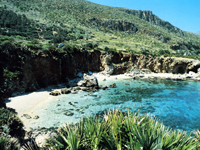
The Zingaro Reserve - San Vito Lo Capo
Between Castellammare del Golfo and Trapani there is one of the most magical corner of Sicily: narrow and ancient paths lead up to a wonderful oasis surrounded by the typical Mediterranean environment with evergreen trees and shrubs on a rocky ground.
The only thing you can do in front of such a wonderful landscape is keep on being surprised. Massive calcareous walls tumble over a rich vegetation. The blue seawater shades into green. Depths can be admired with the naked eye. The sea gently caresses the white beaches of the small creeks and penetrate inside the submerged caves to hide and show the lives of fish and plants of this area.
The rich vegetation of the Reserve is the favourite haunt for different species of birds and mammals, some of them very rare. A lot of tourists who want to strenghten their soul and body go on a pilgrimage to the small inlets along the coast during the summer, a small uncontaminated and jealously protected paradise.
It is a place that has been tormented and protected by the rough rocks for millenniums, colored by the green of the typical flora of the area and the blue water loved by men and animals. Sheperds and farmers cultivated it for a long time and never damaged it so that today the 1600 hectares of the Reserve and 7 kilometers of the coastline area true natural paradise.
How to have fun in the Zingaro Reserve
- The long trails of the reserve are perfect for walking tours and to do trekking
- The wonderful submarine caves and surprising depths are a paradise for divers
- Equipped areas where to do a picnic are perfect for a relaxing day.
- The Museum of Maritime Activities and the other one of Rural Civilization can tell you the history and the ancient rituals of these places
- And finally... birdwatching for who loves it
Entrance – There are two entrances to the Reserve:
- South: from Scopello - main entrance with accomodation for tourists.
From the highway A/29 (Palermo-Mazara) drive to the junction to go to Castellammare del Golfo. Follow the SS 187 towards Trapani untill the junction to go to Scopello.
- North: from San Vito Lo Capo - Getting to the SS 187 as explained below and then drive to the junctionto go to San Vito.
In both cases you must leave your vehicle in the car parks and then continue on foot.
Rates
Price: 3 €
- Children betwen 10 and 14 ages: 2 €
- Groups: 0.50 €
- Visitors aged under 10: free entry
For further information Tel: 0924 35108
From October to March from 8.00 to 16.00
From April to September from 7.00 to 20.00
Itineraries - Inside the Reserve you can follow different paths. Some of them go long the coast, others allow you to admire the beauty of the interior. You can choose depending on the difficulty and length.
Shelters - In contrada Sughero, inside the reserve, there are shelters where if you make a reservation you can stay overnight in the period between October and May. FLORA & FAUNA
Flora – The typical Mediterranean landscape of the reserve is characterized by many important endemic species.
It is advisable to visit it in spring, when you can enjoy the sight of multicoloured plants in flower and go into rapture at the beauty of the Sword-lily, the Saffron, the Poppy, the Buttercup, the Dianthus rupicola, the Centaurea ucriae, the Snapdragon and the Asperula rupestris. Scattered buildings and old farmhouses that now are museums hide between Olive trees, Ashes, Almonds and Carobs. About 40 endemic species have been classified. One of the most important is the Limonium todaroanum. It is exclusive of the Zingaro and can be found in the most rugged area of the reserve, between the rocks of Monte Passo del Lupo (about 700 meters high). The same area is very interesting because of the presence of the Ilex and Cork oak that once were very common in Sicily but now are very rare. The inaccessibility of this area facilitates the growth of the Purple gromwell, the Silverbush and the Odontites bocconei. There are also small Ferns, Sowbreads, bushes of Butcher’s broom and Thymus. Many typical Mediterranean species spread in Sicily can be founded also in the reserve: the Prickly pear, a fruit trees with a lot of different varieties, the Caper, the Sea fennel, the Oleander, the Bay and the Mallow. The upper area the landscape is very similar to a prairie where there is a herbage that can perfectly survive in dry areas. Probably it indicates the previous presence of the maquis there. You can also find the Hyparrhenia hirta with bright red flowers and many bushes of Disa. Moreover you may admire many terricolous orchids like the Ophrys and the Orchis brancifortii. In the valley of Mount Acci there is an area dominated by Reeds and Sedges that create a good habitat for the Discoglossus, a small Sicilian amphibious similar to the frog, and of the Lenten crab. This environment is very similar to that on the banks of watercourses and so there you can find the same kind of flora: the Salix pedicellata, the Hoary Elm and the Dorycnium rectum. The Fan palm is the queen of the reserve. It dominates the whole landscape. Normally it is smaller but the favourable conditions of the Zingaro reserve allowed it to grow like a tree.
It is the only palm that spring up spontaneously on the island and dates back to an age prior to the last ice age, when the climate was tropical. In the past the Fan palm was used by local people to build many objects of everyday use like brooms, baskets and mats. That clarify the origin of its dialect names: Giummarra, Scupazzu and Scuparina. For further information on the flora of the Zingaro Reserve you may refer to the herbarium kept in the Visitors Center of the reserve. Fauna – The reserve is full of life. There are a lot of small animals that there can survive. During a quiet walking you can see some of them.
It is a varied environment with rocky walls, prairies, trees, shrubs and a large number of plants of all kinds where many animals can feed and be protected. Besides many species typical of this area, the reserve is pride to welcome some endangered species that in this uncontaminated corner of Sicily can still survive. Birds – Some 40 different species of birds nest permanently in the reserve. This figure do not include the migratory species that cross it during their migration. The reserve is very pride of the presence of the Bonelli's eagle whose protection was one of the most important reason to establish the reserve. Its progressive disappearance from its natural habitat and the lack of preys endangered more and more its survival. There the Bonelli's eagle has everything it needs. It nests always in the high areas of the reserve, on cliffs and rocky walls, and can hunt its favourite prey, the wild rabbit, that is very widespread in the reserve. The Alectoris graeca whitakeri found there the ideal conditions to survive as well. The hunting activities and the environmental changes endangered its survival everywhere else. It is a small endemic Sicilian fasianides, recognizable by its black ruffle that differentiate it from the continental species. The Alectoris graeca whitakeri lives in the most hidden places between the steep rocks and the scrub. Walking through the trails of the reservation you can easily see the Kestrel, a small bird of prey with sharp wings and a tight tail, the Peregrin diving on its prey and the Swift with very large wings that is very skilful at flying but bungling to alight. You can also see the acrobatic flights of the Common Raven and of the Buzzard. In the meanwhile the Wren sings very strong and the Nightingale cheers with its warbles. Perched on a branch there can be the Blue rock thrush with its characteristic blue plumage or the Bunting, a small passerine bird with a thin beak. You can also hear Crows, Magpies, Sea gulls and wild pigeons flying around. At night flying the Tawny owl, with big black eyes and a soft plumage, and the Owlet, with a brown-white plumage and a big flattened head, supervise the reserve. In the open areas you ca easily see the Whinchat, a small passerine bird now becoming extinct because of the alteration of its natural habitat, the Goldfinch, a protected species with a bright plumage and a very nice singing, the Wheatear, an insectivorous whose plumage changes according to the season and to the sex, and the Black-throated wheatear, a small tawny passerine bird. In the shrubby areas there is the Sardinian warbler, an elegant insectivorous with a grey plumage and a black head that can be easily recognized by the red circle around its eye. Mammals – While you are walking the less frequented paths of the reserve you can found some aculeus. They belong to one of the so many Porcupines of the reservation. They are solitary animals that prefer the quieter corners overgrown with bushes. In the reserve there are also Foxes and Weasel, which are specialized in preying on small mammals and rodents. The role of these predators is important for the equilibrium of the reserve. As a matter of fact the excessive reproduction of some species, especially rabbits and snakes, is restrained by the right implementation of the well-known food chain. Reptiles – The Sicilian wall lizard is an exclusive species of the island. It is about 7 centimetres long and has a big head. It can be recognized by its green back with clearer lateral streaks. The Sicilian wall lizard lives generally in grassy soils and usually do not climb any slope unlike the Gecko and the Hemidactylus. The Gecko can climb easily everywhere, even upside down, thanks to its numerous pads in its legs. It is very similar to the lizard. They differs in a bigger body and a darker colour. The Ocellated Skink is a small insectivorous which has a very long body whose head can not be distinguished so well. Its name comes from the dark rim around its eyes. Amphibians – In the damp area of the small superficial rivulet you can see the rare Lenten crab and the Discoglossus pictus. The Lenten crab is less known in comparison with its marine homologue especially because it is rarer and rarer because of the pollution and the gradual disappearance of small watercourses where it lives. It is a big crustacean with huge claws and very big eyes. The Discoglossus pictus can not be found elsewhere in Italy. It is similar to a frog, is about 5 centimetres long on average and has a tongue rolled back with different limits from which its name derives. The Discoglossus pictus belongs to the protected species listed on the European Directive 92/43/EEC on the conservation of natural habitats. At the bottom of the sea – You go into raptures watching the limpid sea water with no secrets revealing all the mysteries of the Sicilian sea. Among the Anemones, Madrepores and Sponges there are many coloured fish, small red coral formations and a lot of fantastic wonders more.
|

